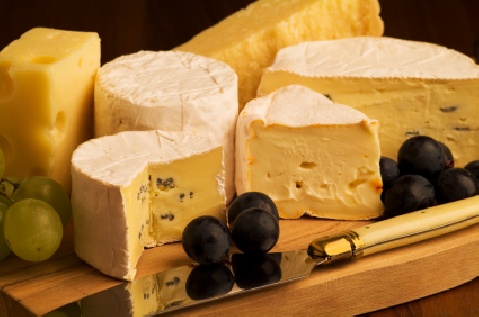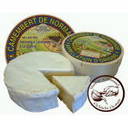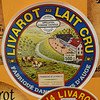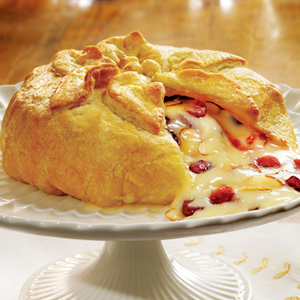How Can You Select
The Best French Cheeses?
Here's My List from A-L

The labels on some French cheeses contain the letters A.O.C.. What does this mean?
Literally, A.O.C. means Designation of Controlled Origin - or - Appellation d'Origine Controlée.
Similar designations describe certain Italian cheeses - D.O.P. or Denominazione di Origine Protetta - and certain Spanish cheeses - D.O. or Denominacion de Origen. These official designations represent a system of standards that are used for certain food products and wines. When applied to cheese, the A.O.C. designation guarantees that the French cheese adheres to certain mandated standards, is made using specific traditional techniques and that it has consistent and distinctive flavor, texture and appearance characteristics.
Specifically, you, the consumer, can be sure of the following:
1. the French cheese's origin (such as the town of Meaux or the region of Normandie) and often the breed of animal whose milk is used to produce the cheese;
2. the cheese has been made using traditional methods, some of which might date back 1000+ years;
3. the shape, size, texture, minimum fat content etc. of the cheese is regulated;
4. the country (France) stands behind the cheese and guarantees its authenticity and quality.
The A.O.C. (as well as the D.O.P and the D.O.) carry more weight than the Good Housekeeping Seal of Approval! There are plenty of terrific French cheeses which do not carry the A.O.C. designation for various reasons and I don't mean to exclude or disparage any of them.
It's really very difficult to select just 15 cheeses out of the many hundreds produced in France! It's a tough job, but someone's got to do it! So after much soul searching, tasting, comparing and sipping appropriately paired wines ... I have come up with my short list of Outstanding French Cheeses. 14 of the 15 have the coveted A.O.C. designation. Use this list as a starting point to create your own Favorites List! And please share your list with me and the visitors to the Gourmet Cheese Detective website!
1. Banon (A.O.C.), a French cheese made from raw goat's milk, is best consumed very fresh. It is typically ripened for just 2-3 weeks, but sometimes aged up to 2 months. Produced in Provence in the south of France, true A.O.C. designated Banon is almost impossible to find in the U.S., due to the laws preventing importation of raw milk cheese which has been aged less than 60 days. So look for it on your next trip to France where you will find small, flat rounds of Banon wrapped in leaf wrappers which have been soaked in spirits - wine or marc (a French brandy), and tied with raffia twine. French Banon will have a fruity flavor, as you might expect from the soaked wrapper. As a young cheese, it will be crumbly and tangy/tart. But if it is allowed to age a bit, the leaf wrapper will darken naturally and the cheese paste will begin to liquify and ooze, developing a stronger fruity and nutty flavor.

One of the best French brands is Fromagerie Royannais-Teche. While this company does export to the U.S., it is a less desirable version made to comply with U.S. regulations. Instead I recommend that you buy Judy Schad's U.S. made Capriole Farm's O'Banon, mentioned in the American Artisanal Cheeses section of this website. It is an outstanding alternative for those who cannot travel to France this year - and some would say it is even better than the raw milk Banon produced in France!
2. Brie de Meaux (A.O.C.) or Brie de Melun (A.O.C.) and/or Camembert de Normandie (A.O.C.). I am cheating a bit here, including 3 French cheeses under Choice #2! But there are great similarities among them and all three have the A.O.C. designation and long traditions

These cheeses are made from unpasteurized (raw) cow's milk and are classified as soft, uncooked bloomy rind cheeses. The two Bries are typically produced in 5-6 lb. wheels so that you would buy them already cut into wedges. Camembert de Normandie is made into small 5-10 oz. wheels and packaged in the familiar thin, wooden wheel-shaped boxes. All 3 cheeses have soft, creamy textures and as they ripen to their best (à point) they will be almost oozing in consistency. The paste (interior) is straw colored or very pale yellow when ripened, and the thin bloomy rind will be white and velvety to the touch, changing in color to reddish as it ripens. When made in true artisan fashion (as all the A.O.C. cheeses are), these 2 Bries and the Camembert de Normandie will have very rich flavor, slightly sweet and nutty.

Brie de Meaux, produced in the Île de France region near Paris, dates back to the time of Charlemagne in the 8th century. By 1815 it had become truly famous when Talleyrand designated it at the Congress of Vienna ... as the King of Cheeses. Other cheeses have also been called King of Cheeses - Roquefort and English Farmhouse Cheddar, for example. True A.O.C. Brie de Meaux cannot be imported into the U.S., but there is a pasteurized version available in the U.S., known as Fromage de Meaux. Rouzaire is an excellent maker of Brie de Meaux and produces both the French A.O.C. version and the imported Fromage de Meaux version.
Brie de Melun, produced in the southern part of the Île de France region, has slightly different A.O.C. standards of manufacture. It will taste just slightly stronger and will be a little firmer than Brie de Meaux. It cannot be imported into the U.S.
Camembert de Normandie (A.O.C.) probably made its début in the late 1700s. Like the word cheddar, camembert is not an origin controlled word. So there are many camembert cheeses made in Europe and the U.S.. In fact, only 6% of all camembert cheese produced in France is true A.O.C. Camembert de Normandie! Good names to look for are: Moulin de Carel, Ferme de la Héronnière and Grand Beron, all of which produce A.O.C. Camembert de Normandie.
Try the ultimate recipe forBrie (or Camembert) en Croute.

3. Named after the famed Jean Brillat-Savarin, an 18th century épicure and gastronome, this renowned triple-crème French cheese is produced in the Normandy and also Burgundy regions of France. It is not an A.O.C. designated cheese.
Brillat-Savarin was first produced in the 1930s. It is made from both pasteurized and unpasteurized (raw) cow's milk. Brillat-Savarin, like other triple-crème cheeses, is a bloomy rind cheese with a soft velvety rind and an interior paste which is off-white to pale yellow in color. Cream is added in the production process to increase the butterfat content to a minimum of 74%. Decadently delicious to the taste, Brillat-Savarin dissolves in your mouth. Soft and oozy, the texture is moist and the flavor is rich, buttery and sweet. Look for La Ferme imports brand, which is a Brillat-Savarin selected by Pierre Androuëts. It is packaged in a round wooden box. Pierre Robert is a very similar triple-crème cheese ... and frankly ... it is virtually a toss-up between the two!

Jean Brillat-Savarin is believed to have said " A meal without some cheese is like a beautiful woman with only one eye." (Yes, he did take his cheese seriously...)

4. Crottin de Chavignol is among the most popular of the French cheese chêvres (goat cheeses) in France. The authentic A.O.C. Crottin de Chavignol must be made from raw goat's milk around the small town of Chavignol, near the town of Sancerre in the central Loire Valley. There are also many non A.O.C. versions of Crottin, produced in that region, which are just as good. Best to look for one of the 30+ producers which have the word "Fermier" (farmstead) on the label. Examples are: Jacquin and Bougon. In the U.S. your best bet is to look for the pasteurized goat's milk version which is called Crottin de Champcol.
When selecting this cheese, look for one that is not too young (white exterior) ... nor too old (dark brown exterior). The cheese is typically aged from 3-4 weeks, up to 4 months, so pick one with a beige exterior which has been aged about 2 months if possible. As the cheese ages, the texture will change from semi-soft to more firm and crumbly; the flavor will change from quite mild to very rich and pungent. Crottin de Chavignol is a rustic cheese, and pairs very well with the renowned dry white wine of the region, called Sancerre. Please don't be put off by the literal translation of the word "crottin", which means horse turd! It is simply a descriptive reference to its shape, a small flat disc about 2" in diameter.
5. Like Crottin de Chavignol, A.O.C. Époisses de Bourgogne is name-controlled. You can only buy the true A.O.C. raw cow's milk version in France - look for either the Berthaut brand or the Germain brand. It is classified as a washed-rind "stinky" French cheese. If you like washed-rind cheese, then this one is for you!

Époisses de Bourgogne is thought to date back to the 1500s and was probably first made by Cistercian monks in the Village of Époisses in the region of Burgundy. By the time of Napoleon it had become very popular and in fact was one of his favorite cheeses. Brillat-Savarin praised it highly and called it the King of Cheeses. (So many cheeses have received the same acclaim that one almost tends to discount the phrase! But it does reveal just how passionately people can feel about their favorite cheeses!)
True connoisseurs of washed-rind cheeses know that while the aroma or smell can be really "stinky" and off-putting ... a well-made artisan or fermier washed-rind cheese, perfectly aged, will have a well-rounded, balanced and complex flavor. The cheese is washed daily in a brine of water and marc (brandy made from grape skins and seeds), which causes the bacteria to spread and the mold to develop. As it ages over a period of 5-6 weeks, the exterior rind will become a reddish-orange and the interior paste will change from smooth and creamy to a gooey, thick, spoonable texture. Simply delicious! If you have not tried Époisses de Bourgogne, you owe to yourself to try it - or one of the local fermier producers of Époisses in the Burgundy region, preferably paired with a big red Burgundy wine. You will find Époisses de Bourgogne, and other non A.O.C. Époisses, packaged in small round wooden boxes which come in several sizes. Check the label to be sure you are buying an artisanal or fermier (farmstead) Époisses. In the U.S., alas, we must settle for a pasteurized version, which while very tasty, is not quite as good as the raw milk version.
6. A.O.C. Fourme d'Ambert is an ancient recipe French blue cheese made from raw cow's milk. Pasteurized versions are also available. Fourme d'Ambert is one of just 32 name-controlled cheeses in France. A similar or related cheese to try would be Bleu d'Auvergne. Both cheeses are produced in the Auvergne region of south central France ... and like all blue cheeses, are natural rind cheeses with no special

treatment given to the rind. (The rind is inedible, by the way). Fourme d'Ambert has lots of flavor, with thick pockets of blue throughout the interior paste underneath the rind. The paste will be white to straw-colored and will not be as strong, sticky or sharp as the well-known Roquefort. Compared with the British Stilton, Fourme d'Ambert is a little moister, not quite as dry and crumbly. Fourme d'Ambert is shaped during production by a wooden mold ("fourme") into 5 lb. cylinders and is typically aged from 1 to 5 months.
Note: A fun taste challenge for you and your friends would be to place portions of Stilton, Roquefort, Fourme d'Ambert and Gorgonzola on a plate and see who can identify each correctly. Does one of the four stand out as the favorite and if so, why? Try to detect the nuances of taste, texture, appearance and aroma.
The Roussel brand is a good name to try. If you cannot find Roussel, look for one of the artisan or fermier produced brands from the Auvergne region.
7. A.O.C. Livarot is another excellent washed-rind French cheese which will appeal to those who prefer really "stinky" cheeses! It has been made in the departement of Calvados in the Normandy region for centuries, dating back to at least the 13th century. A good French brand to look for is La Ferme de la Viette, which is an A.O.C. Livarot made from raw cow's milk. A very good pasteurized milk version is available in the U.S. - look for Levasseur. Livarot is similar to Époisses de Bourgogne and Pont l'Évèque, both of which are included in this list of 15 outstanding French cheeses.

You can easily identify Livarot because it is wrapped in orange paper, encircled with 5 strips of raffia and encased in a thin round wooden box. It comes in 3 sizes: 3", 3 1/2" and 4". Like all washed-rind cheeses, it is regularly washed in brine, with annatto added to the final bath to give the rind its distinctive orangeish color. The rind itself is smooth, not sticky and the interior paste will be pale to light yellow with a very strong, moist flavor when eaten during its very brief, perfectly ripe stage. Once it has passed its prime ripe stage Livarot quickly becomes ... in a word ... putrid, and you will know it! It is typically aged from 3 weeks up to 5 months, with 2 months being the most common period of aging. Enjoy this fine cheese wtih some Calvados (the apple cider brandy made in the same Normandy region), or with a big red wine.
That ends Part 1 of my Outstanding French Cheese List. Please click on the link below to go to the continuation of this list - French Cheeses M to Z - for 8 more outstanding French cheeses for you to try! And you might also like to investigate my page on French Regions with a helpful map of reference. See that link below.
You simply can't eat French cheese without thinking about what French wine would be a wonderful accompaniment. You can click on the link below to find out more about pairing French cheeses with French wine.
Go to French Cheeses M-Z
Go to Pairing French Cheeses with Wine
Go to French Regions
Go to Swiss Mountain Cheeses
Read about Pairing American Artisanal Cheeses with Wine
HOME › French Cheeses A-L

Looking for something specific on GourmetCheeseDetective.com?
Enter your request below:
Follow The Gourmet Cheese Detective on Twitter: @The_Cheese_Tec
Make Your Investigation of Gourmet Cheeses a Memorable One With Our Gourmet Cheese Detective's Notebook:

As any good Detective knows, keeping a record of your investigations is a must! Use this concise caseophile's pocket notebook to keep track of your Gourmet Cheese discoveries. Record your favorite cheeses, keep memos of your travels in the world of Gourmet Cheese, and compare notes with the other Gourmet Cheese Detectives you meet! Click on the image above to order your Gourmet Cheese Detective Notebooks now! - G.C.D.
The Ultimate French Cheese Guide!
French Cheeses: The Visual Guide to More Than 350 Cheeses from Every Region of France

Designed for both amateur enthusiasts and serious gourmets. Organized alphabetically, each cheese, its
seasonal availability, regional origin, and properties are described
concisely and clearly. Accompanying the entries are invaluable
photographs of the cheese in its various states, both outward bulk and
sliced through, for easy identification. In addition, every listing
offers wine recommendations by international connoisseurs Robert and
Isabelle Vifian. Click on the image to order your invaluable copy today! - G.C.D.
Take a Visual Tour of France
Travel to France (2008)

Immerse yourself in French culture with a visit to Roquefort to see the
creation of the famed and delicious blue cheese before embarking on a whirlwind
tour of the wonders of Paris, from the Eiffel Tower and Notre Dame to
the Arc de Triomphe. Click on the image to order your DVD now! - G.C.D.
Wish You Could Live Like Real World Travelers?

Dreaming of traveling the world enjoying Gourmet Cheeses in their native environs? Go on a global adventure from Irish Georgian mansions to windswept
coasts of Portugal, from Turkish bazaars to the contact sport of
Italian grocery shopping with Lynne and Tim Martin’s book, Home Sweet Anywhere. It is
a road map for anyone who dreams of turning the idea of life abroad into a
reality. Click the image above to order your copy today and begin your own explorations! - G.C.D.
Try These Recipes Using French Cheeses:
